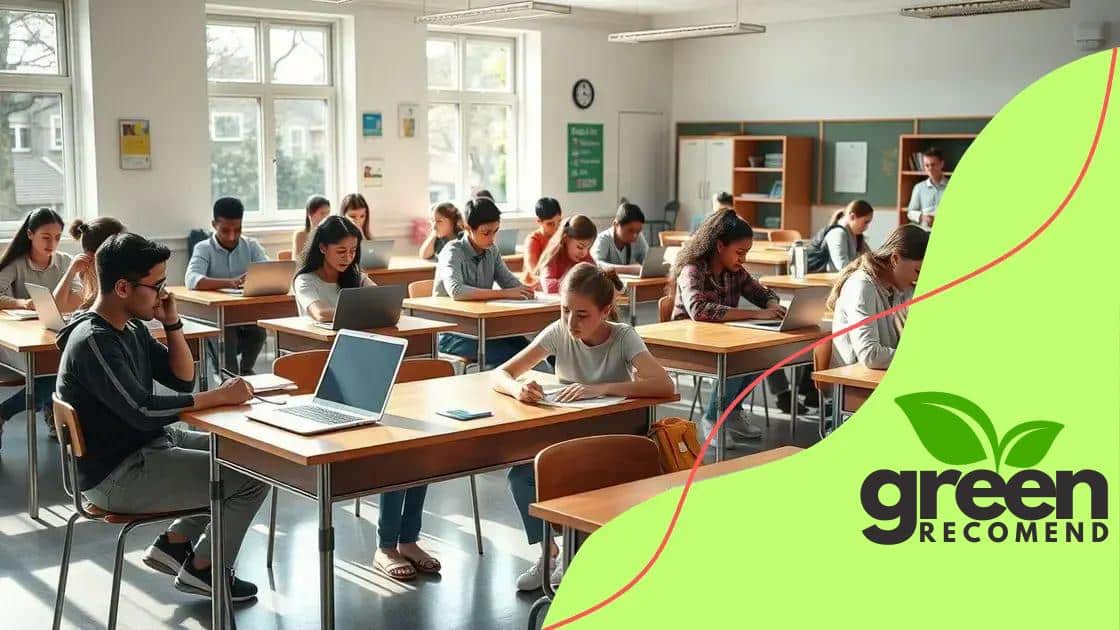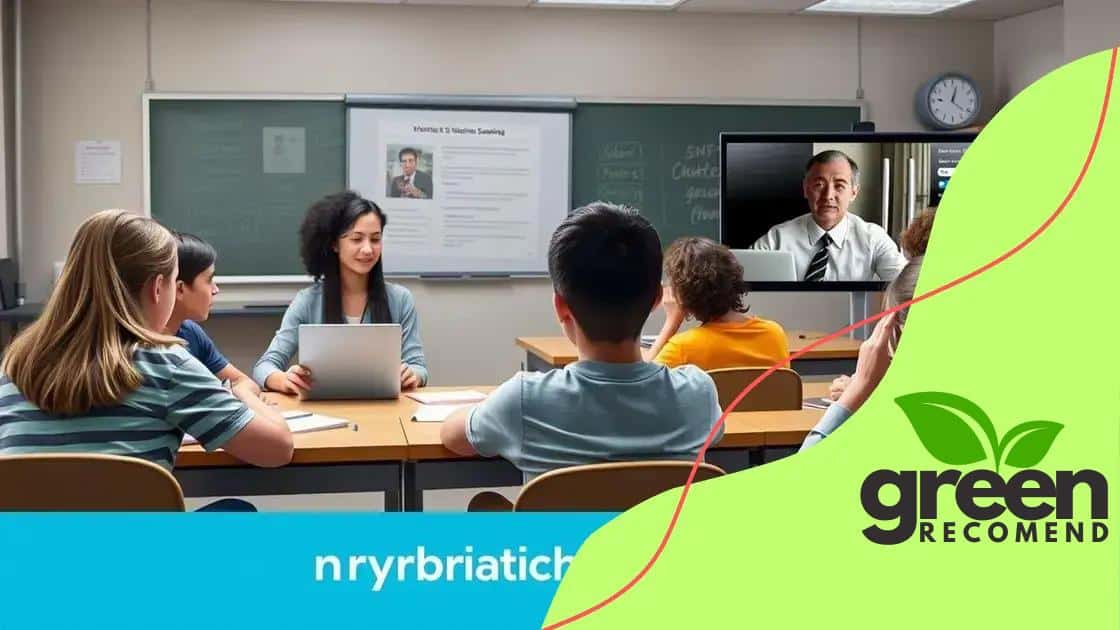Hybrid learning methods and their success in schools

Hybrid learning methods combine traditional in-person education with online learning, enhancing student engagement and flexibility while addressing challenges like technology access and teacher training.
Hybrid learning methods are changing the landscape of education by blending traditional classroom experiences with online learning. Have you ever wondered how this approach can boost student success in schools? Let’s dive into this innovative topic.
Understanding hybrid learning methods
Understanding hybrid learning methods is crucial for recognizing how they reshape education. This innovative approach combines traditional in-person classes with online learning, providing flexibility and accessibility to students.
Hybrid learning allows students to engage in their studies both at school and from home. This method supports different learning styles, helping teachers reach each student effectively.
Key Features of Hybrid Learning
There are several essential components that define hybrid learning. By understanding these features, educators can implement more effective strategies.
- Combination of online and face-to-face instruction.
- Flexibility in learning pace and location.
- Increased engagement through multimedia resources.
- Personalized learning experiences.
As we explore these characteristics, it’s clear that hybrid learning methods can cater to diverse student needs. Students can engage with the material using various formats that suit their preferences.
Benefits of Hybrid Learning
One of the significant benefits of hybrid learning is that it allows greater student autonomy. They can choose when and where to learn, enhancing their motivation and responsibility.
- Improves access to resources and information.
- Encourages self-directed learning.
- Facilitates collaboration among peers.
- Prepares students for future workplace environments.
Additionally, teachers can leverage technology to track progress and provide timely feedback. This dual approach creates a more enriched learning experience.
In summary, hybrid learning methods offer a versatile educational framework that can accommodate the evolving needs of students and educators alike. Understanding these methods is the first step to harnessing their full potential.
The impact of hybrid learning on student engagement
Hybrid learning has a significant impact on student engagement. By blending in-person and online instruction, it caters to various learning preferences, making education more interactive and accessible.
Students in hybrid settings often feel more empowered to take control of their learning. They can explore topics at their own pace, leading to greater interest and participation. This approach encourages them to engage with the material in a way that feels comfortable to them.
Enhancing Interaction
One of the most notable effects of hybrid learning is the increased interaction among students and teachers. In-class discussions can be enriched with online tools that allow for immediate feedback and collaboration.
- Online platforms enable students to share ideas easily.
- Discussion boards foster community among learners.
- Virtual meetings encourage participation from all students.
- Real-time polls can gauge understanding and keep students involved.
The use of technology helps students stay connected with their peers and teachers, even when they are not physically in the classroom. This camaraderie can lead to a more engaging learning environment.
Motivating Students
Hybrid learning can also boost motivation levels. When students have the choice to learn in various settings, they’re more likely to feel excited about their education. Incorporating multimedia resources, such as videos and interactive activities, makes lessons more appealing.
- Gamification can make learning fun and competitive.
- Diverse content keeps students curious and eager to learn.
- Flexible schedules accommodate different learning styles.
- Opportunities for self-directed learning foster responsibility.
This motivation is crucial for success, as engaged learners are more likely to perform well academically. As students stay motivated, they tend to retain information better and exhibit a deeper understanding of the subject matter.
Challenges of implementing hybrid learning

Implementing hybrid learning methods presents several challenges that schools and educators must overcome. While this approach offers flexibility, it also requires careful planning and resources.
One major issue is the need for reliable technology. Schools must ensure that both students and teachers have access to devices and stable internet connections. Without this foundation, the effectiveness of hybrid learning can be severely compromised.
Training for Educators
Another significant challenge is providing adequate training for educators. Transitioning to a hybrid model involves new teaching strategies and tools that educators may not be familiar with.
- Professional development programs are vital for helping teachers adjust.
- Training should focus on effective online teaching practices.
- Educators must learn to manage both in-person and online classrooms simultaneously.
- Support from experienced peers can ease the learning curve.
When educators feel confident using technology and hybrid methods, they can better engage their students and enhance the learning experience.
Student Engagement and Equity
Maintaining student engagement is another challenge. Some students may struggle to stay focused during online lessons or may feel isolated. Educators need to develop strategies to keep all students involved, whether they are in the classroom or learning from home.
- Interactive activities can help keep students engaged.
- Frequent check-ins with students can build connections.
- Group projects can foster collaboration, even online.
- Teachers should monitor participation and adapt strategies as needed.
Another important aspect is equity in learning opportunities. Not all students have equal access to resources, which can create gaps in learning outcomes. Schools must address these disparities to support every student’s success.
Case studies of successful hybrid learning schools
Examining case studies of successful hybrid learning schools provides valuable insights into how this approach can be effectively implemented. These examples showcase innovative strategies and positive outcomes that can inspire other institutions.
For instance, some schools have combined traditional teaching with digital tools to create engaging lessons. By using online platforms, teachers can track student progress and personalize learning experiences.
Example 1: Green Valley High School
At Green Valley High School, the hybrid model allows students to choose between in-person and online classes. This flexibility has led to increased attendance rates and higher student satisfaction. Teachers use digital resources to supplement lessons and facilitate group projects that can be conducted online or in person.
- Students reported feeling more motivated in their studies.
- Teachers noted improved collaboration among students.
- Parental feedback has been overwhelmingly positive.
- Attendance rates rose by 20% after implementing the hybrid model.
This school highlights the importance of giving students options, allowing them to learn in a way that fits their needs.
Example 2: Oceanview Academy
Oceanview Academy focuses on younger learners and has embraced hybrid learning successfully. The school utilizes interactive online tools that keep young students engaged. Teachers rotate between leading in-person sessions and virtual classes, maintaining a consistent curriculum across both formats.
- Interactive lessons use games and quizzes to reinforce concepts.
- Daily interactions with teachers help build strong relationships.
- Parents appreciate the additional resources provided for at-home learning.
- The school saw a significant improvement in student achievement scores.
This model demonstrates the effectiveness of adapting hybrid learning to suit younger audiences, making education fun and accessible.
These case studies illustrate that when implemented thoughtfully, hybrid learning can lead to substantial benefits. Schools can enhance student engagement, satisfaction, and achievement while accommodating diverse learning preferences.
Future trends in hybrid learning education
Future trends in hybrid learning education are shaping how students, teachers, and schools interact with learning. As technology advances, the approach to education will continue to evolve, creating new opportunities for students and educators alike.
One trend is the increasing use of artificial intelligence (AI) in education. AI can personalize learning experiences by analyzing student performance and adapting content to meet individual needs. This customization makes learning more engaging and effective.
Enhanced Learning Technologies
Another important trend is the development of enhanced learning technologies. Virtual reality (VR) and augmented reality (AR) resources are becoming more accessible and affordable. Schools can use these technologies to create immersive learning environments that make topics more appealing.
- Students can explore historical events or scientific concepts through interactive experiences.
- Virtual labs allow for hands-on experiments without the need for physical materials.
- Interactive simulations can help students grasp complex ideas faster.
- This technology supports both in-person and remote learning.
In addition, more collaborative tools and platforms will emerge, allowing for better communication and interaction among students, teachers, and parents. These tools will help maintain strong connections regardless of learning modalities.
Focus on Social-Emotional Learning
Future hybrid learning models will also place a greater emphasis on social-emotional learning (SEL). Educators will recognize the importance of students’ emotional well-being and how it impacts their academic success. Schools will incorporate SEL practices into their hybrid programs, fostering a supportive environment that encourages mental health and resilience.
- Increased training for teachers on SEL strategies will be essential.
- Students will have opportunities to engage in mindfulness and emotional regulation activities.
- Community-building exercises will help develop strong peer relationships.
- SEL will be integrated across the curriculum, enhancing overall student experience.
These future trends highlight the potential of hybrid learning to create a more personalized, engaging, and supportive educational environment. As the landscape of education changes, it is important to stay informed and adapt to these advancements.
In conclusion, hybrid learning methods are transforming education by combining traditional and modern approaches. As schools adopt these practices, they see benefits like increased student engagement, flexibility, and access to resources. However, challenges remain, including the need for proper technology and training. By addressing these issues and focusing on future trends, such as the integration of AI and social-emotional learning, schools can create enriching environments that cater to the diverse needs of students. Embracing hybrid learning can lead to a more successful and inclusive educational experience for all.
FAQ – Frequently Asked Questions about Hybrid Learning Methods
What are the benefits of hybrid learning?
Hybrid learning combines in-person and online education, increasing student engagement and providing flexibility in learning.
What challenges do schools face when implementing hybrid learning?
Schools often struggle with technology access, teacher training, and ensuring student engagement.
How can technology enhance hybrid learning?
Using tools like AI and interactive platforms can personalize learning experiences and facilitate collaboration.
What future trends can we expect in hybrid learning?
Future trends include increased integration of artificial intelligence, social-emotional learning, and the use of advanced technologies like VR and AR.





